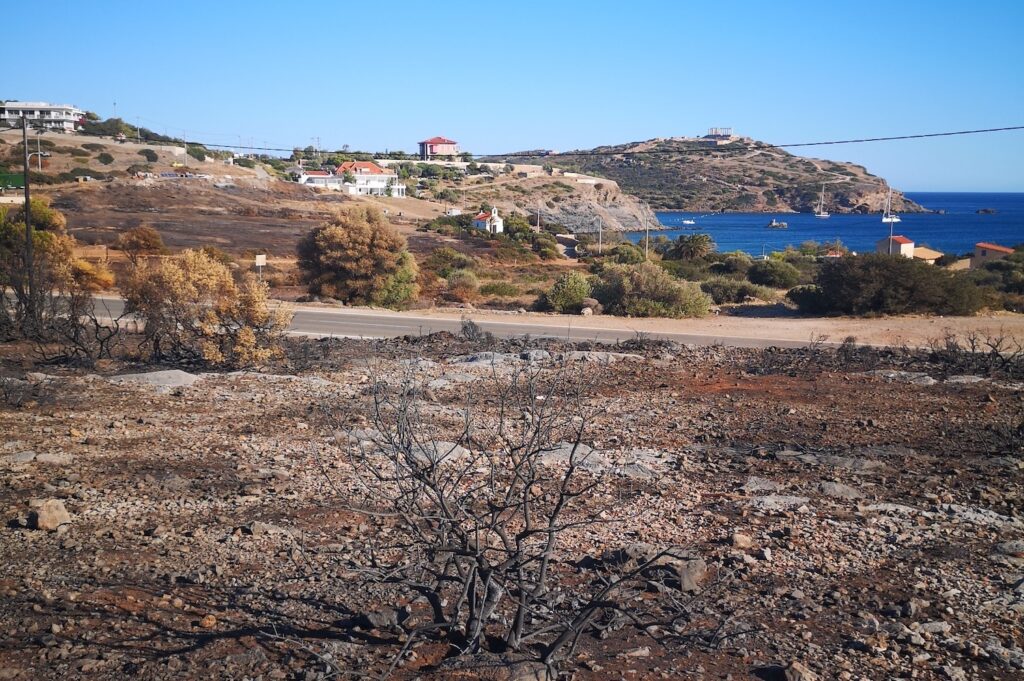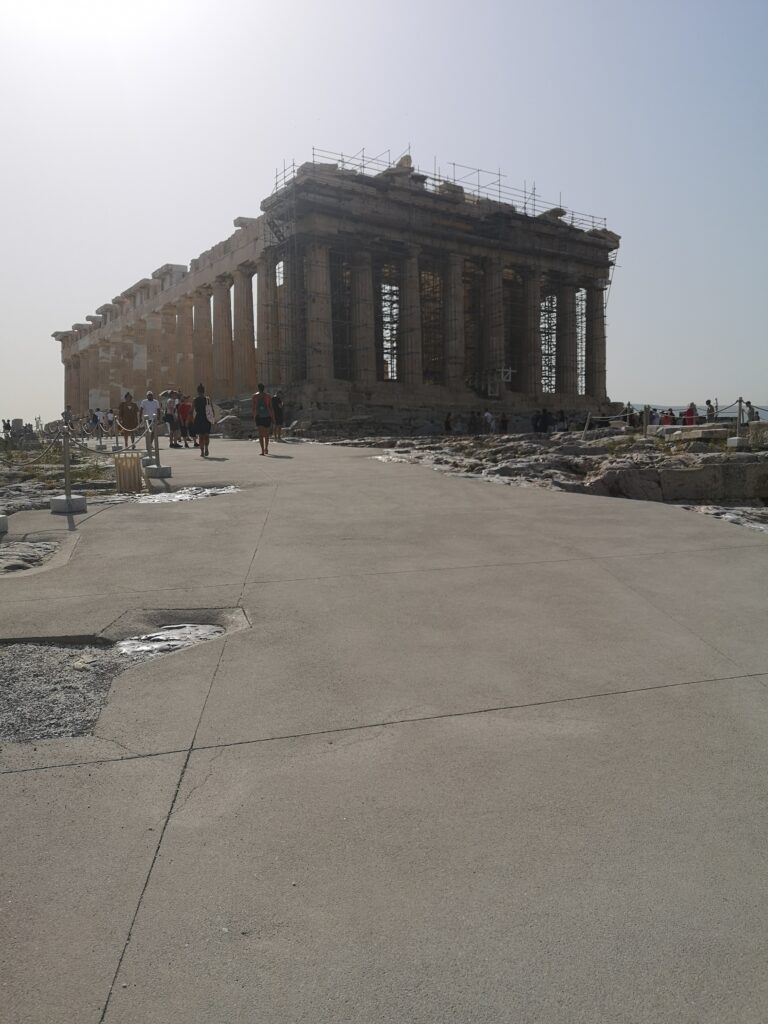In Greece, during the summer of 2021, we saw again a proliferation of wildfires that went on for days, like in 2020. While the climate change argument makes sense, at the same time Greece has experienced wildfires for many decades now. In the post-dictatorial Greek popular imaginary, fire represents the creative destruction process of a violent disjunctive modernization, led by a quasi-illicit capitalism based on the construction boom. Across Greece, one can hear stories about great wildfires that flattened forests and green mountainsides only to see villas, casinos and tourist resorts growing in their place some years later. Tied to the monolithic emphasis on an economic growth strategy based almost entirely on tourist services, wildfires over the last decades have facilitated the expansion of tourist infrastructures and the built environment. The systematic exploitation of gray areas (parathirakia/παραθυράκια) in Greek environmental law and urban planning law have facilitated these opportunities (see Dalakoglou and Kallianos 2019). Factual or not, such arguments have been enhanced during the recent wildfires, as many informants of the infra-demos project are noticing that during the early years of the financial crisis (2010-2016) when real estate, tourism and infrastructures investment saw a drop, one also witnessed a noticeable decrease in wildfires, for the first time in decades. Although we cannot confirm such datasets on wildfires, if one takes as case study the ways that the state protects archaeological sites from wildfires and other risks, there is arguably an implied link with specific shifts in the Greek state’s touristic growth strategies.
Antiquities on Fire
In one of these usual wildfires in August 2020, some shocking news came to the attention of the Greek public. The famous Lion Gate of Mycenae, erected in 1250 BC, was set ablaze as the Greek civil protection agencies failed to protect it from a wildfire that had flared up in the area. The Greek government downplayed the issue, stating that no real damage had been done. Many local informants of Poulimenakos claimed that during the previous years there had been fire-brigade forces near the site for its protection, but they were not present that summer.
In August 2021, Greece faced perhaps the most destructive wave of wildfires in its recent history, with more than a million acres of forest turned into ashes. During this wave, the archaeological site of ancient Olympia in Peloponnese was almost eradicated, with people on the site talking about the pure luck in the guise of a change in the wind direction, which ultimately prevented that catastrophe. The official policy of the Greek state was to evacuate the area and protect human lives, with saving the forest or the archeological sites seen as less of a priority. A few weeks earlier, the most important archaeological site in the Attica region outside the Athens metropolis, Poseidon Temple in Sounio, saw a wildfire next to the monument. It was extinguished thanks to its proximity to the town of Lavrio, where sizeable forces of fire brigades are stationed, yet many locals mention to Dalakoglou that if it was not for the five-star hotel that was between the ancient temple and the fire, they would not have saved it in time. Another wildfire entered the national park of Sounio later in August 2021.

The Archaeology of Greece 2.0
Earlier in 2021, the Ministry of Culture caused outrage among archaeologists of the country with its actions. To mention a few, a large public construction project was carried out in the Acropolis of Athens to create a large concrete walkway, which was built near the monument during the lockdown. Many compared the construction to a fashion show stage. And the truth is that a few months later, a luxury clothing brand arranged a show on the new cement corridor with the Parthenon as the background for the videos and photos. A few weeks later, Sounio was booked by the same brand for another fashion show. The indifference that the current Ministry of Culture has shown towards ancient sites has other facets. For example, in the summer of 2021, the Minister announced that the entire Byzantine high street in Thessaloniki that was discovered during the public works for the construction of Thessaloniki metro will be removed. The Minister, an archeologist herself, would not consider the proposals to exhibit and integrate the findings within the metro infrastructure, which was promoted by various archaeology associations. The promise that 92% of the site will be reconstructed on the site after the works for the metro are completed did not convince the archaeologists. The metro and the gentrification it will bring to various parts of the city were more important priorities than the findings, which are significant even for a nation with as much archaeological wealth as Greece.


“Greece 2.0” was what Prime Minister Kyriakos Mitsotakis, leader of the neoliberal New Democracy party, named the country’s post-covid recovery plan. Greece 2.0 suggests a plan oriented to all-inclusive hotels, casinos and hip new neighborhoods, signifying a shift to a new tourism model to appeal to different kinds of customers. The city branding and the emphasis on this new type of tourism has been going on for some years now at the behest of Greek tourism policymakers, targeting so-called “high quality” tourists with big wallets. These new categories of tourists are expected to be rich enough to buy cheap metropolitan properties to rent out on airbnb when they are not staying there, thus gentrifying the cities, or to afford the high prices of 5-star tourist accommodation. To put it simplistically, there seems to be a transition from the stereotypical history-aware tourist in socks and sandals wandering around the acropolis, to new categories, with little interest in archaeology (e.g. Western yuppies, Arab sheikhs, Russian oligarchs, and upper classes from emerging economies).
Before the pandemic, there was a widely held idea that Greek tourism is no longer affordable for Greeks and is thus only open to foreigners. The drop in the real income of many Greeks since the crisis of 2010 and the unaffordability, for most Greeks, of tourist products, especially accommodation, has caused this gap. To put it simply, until the early 2010s, there was expensive luxurious accommodation in the islands of Greece, but it was not rare to also find local small units with a cost of 40-50 EUR per night, even in the high session. Today, however, such prices are nothing but a fantasy for many millions of Greeks, who have seen a decrease in their income since 2010. Many people in Greece wait for the state-sponsored ‘social tourism vouchers’ in order to get a few days in one of the many touristic destinations of the country. Yet this affects international tourism too, as the Greek tourist product is addressed increasingly to wealthier classes who look for five-star tourist experiences.
The Resetting of Popular Greekness
As the anthropological preoccupation with infrastructures has taught us, things like social and cultural identities, the relation between the state and its citizenry, and even ideology itself, are not abstract, immaterial ideas installed in the hearts and minds of the people. A very concrete, material basis that shapes particular socio-cultural environments is a prerequisite for social contracts and imagined communities to be shaped. The archeological sites in Greece served in many ways as such infrastructures, as they secured the ideological and, in many instances, also the economic integration of an emerging Greek middle class. As many people (not just the wealthy elites) were profiting from the commodification of the national identity within the touristic industry. Restaurants, hotels, stores selling souvenirs, local and international tour operators, guides, airports, and port infrastructures all relied to a great extent on that same materiality. The creative imagination often has depicted with humor the image of the Greek islander holding a ‘rooms to let’ sign in the port of their island, with museums and archaeological sites having a significant role in this industry. Much of the material basis of the national identity was simultaneously the main axis of the touristic industry.
Of course, Greece is not the only polity that is abandoning its archeological infrastructures and by extension abandoning a classic liberal need for a minimum of social cohesion based on a common sociocultural identity. The destruction of the Notre Dame in Paris some years ago, with the French state failing to secure one of the most acknowledged material symbols of the continent, marked probably the end of the western need to produce relations and continuities with a timeline and a purpose that make sense.
What can this seeming abandonment of a certain kind of archaeological tourism infrastructure tell us about Greece today? As the neoliberal model deepens, the tourist industry is “liberated” from the need to link with a collective identity. This identity traditionally functioned by economically and socio-culturally integrating the lower classes inside Greece, and by addressing mass tourism outside. As this link was inextricably connected with certain material infrastructures, the indifference towards them signifies an era in which the tourist model, and perhaps the very structure of Greek society, will no longer be based on gaining consensus from the lower strata, but in aggressively serving the 1%.
The neoliberal management of the world is sending collective identities and the sense of history or geography into a state of limbo. The aesthetics of a 5-star all-inclusive hotel on a beachfront are almost context-free, a tourist could be pretty much in any of the 5 continents, and in any recent decade, and have a very similar, if not the same, experience. Similarly, the aesthetics of a New York loft, which preoccupies much of the renovation for airbnb purposes in apartments in downtown Athens (even quoting ‘New York style loft’ in the airbnb ad), could be almost anywhere else in the Americas or Europe. What is needed for neoliberalism is a culture of the present expressed in constant transactions. Everything else can be surrendered to the merciless critique of entropy.
Dimitris Dalakoglou is Professor of Social Anthropology at Vrije Universiteit Amsterdam. He is director and PI of the research project infra-demos (funded from NWO-Vidi grant) and co-director of the Lab on Infrastructures Sustainability and the Commons.
Giorgos Poulimenakos holds a Bachelor’s degree in Social Anthropology from Panteion University and a MA from University of Sussex, UK. He is currently a PhD fellow in the ERC-funded project PORTS, based in the department of social anthropology of the University of Oslo. He will be researching the increasing significance of ports and maritime logistics in globalized, contemporary capitalism through the case study of Piraeus, an emerging Greek port in the global market bought recently by Chinese interests.
References
Dalakoglou, D., & Kallianos, Y. (2018). ‘Eating mountains’ and ‘eating each other’: Disjunctive modernization, infrastructural imaginaries and crisis in Greece. Political Geography, 67, 76-87.
Poulimenakos G. & Dalakoglou D. (2018). Airbnbizing Europe: mobility, property and platform capitalism. Online publication or Website, Open Democracy
Cite as: Dalakoglou, Dimitris and Georgos Poulimenakos. 2021. “The Past is on Fire: Wildfires, (Un)imagined Communities and the Shift to the Tourism of the 1%.” FocaalBlog, 30 September. https://www.focaalblog.com/2021/09/30/dimitris-dalakoglou-georgos-poulimenakos-the-past-is-on-fire/
Discover more from FocaalBlog
Subscribe to get the latest posts sent to your email.